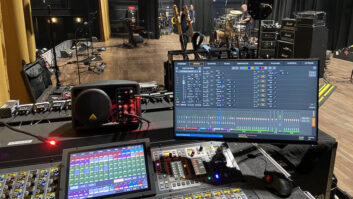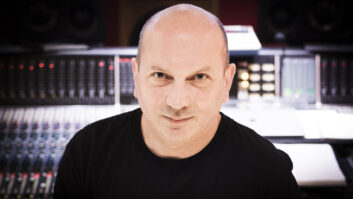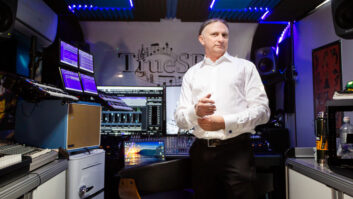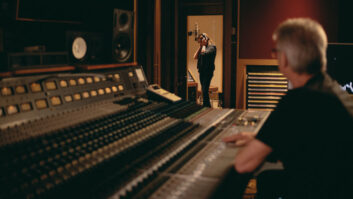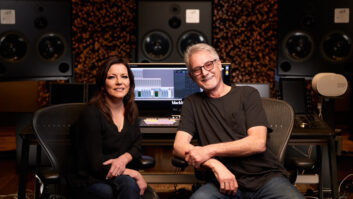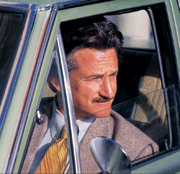
Based on actual events that took place in 1974, The Assassination of Richard Nixon documents the evolution of an ordinary furniture salesman into a would-be assassin who plots to kill the president by hijacking an airplane and flying it into the White House.
Written and directed by Niels Mueller, Nixon stars Sean Penn in the lead role of Sam Bicke. Mueller was already working on the film’s thesis — the progression of a person from “normal” to tragically extraordinary — when he happened upon Bicke’s true-life story and deemed it the perfect illustration. Set in Pittsburgh, the plot unfolds over the course of a year, during which Bicke becomes increasingly isolated and delusional, eventually focusing on then-President Nixon as the source of both his own and America’s problems.
“Sound-wise, it’s a really different kind of movie that I feel lucky to have worked on,” says supervising sound editor Anna MacKenzie of Soundelux, who numbers among her editorial credits Black Hawk Down, The Bourne Identity, The Bourne Supremacy and The Sopranos. “It’s beautifully shot and very realistic in its early ’70s time frame. The sound needed to complement that. At the same time, the film follows a man descending into madness. A major theme is that he’s the only one going there. His friends, his ex-wife, his kids — none of them see the problems with the world that he does. So we had to balance between Sam’s point of view and the world going on around him as usual.”
“When I first sat with Emmanuel Lubezki, the cinematographer, to talk about shooting the film,” comments Mueller, “I said that this film would be as singular a point of view as you’ll ever see in a movie. The success of the film depended on the audience taking this journey through Sam’s eyes. Anna really helped by also taking the journey through his ears.”
“We started with Sam and his perspective,” MacKenzie adds. “For example, there’s a scene where he visits his ex-wife’s house. His children are in the background, but you don’t really hear them until they interrupt him. It’s about what Sam notices. When we had those pieces down, we added the rest of the world as a counterpoint.”
Weaving in and out of the soundtrack is a constant flow of media: television and radio news dominated by the unfolding Watergate scandal and congressional hearings. Prior to post-production, Mueller and picture editor Jay Cassidy auditioned Watergate hearing tapes and a vast amount of original news footage.
“At the beginning of the movie, Sam isn’t aware of world news,” MacKenzie explains. “As the story progresses, he becomes inundated with it. It becomes part of his motivation for the assassination. It’s almost constantly there, and we had to fit that in, sometimes in the background, sometimes more prominently, with normal backgrounds taking a back seat. It was from different sources and of varying sound quality, but most of it had already been digitized for us. Niels and Jay had been living with the recordings for a long time, but we still had sessions where I’d load in Watergate tapes and we’d pick through to find pieces for different sections. Then it was a matter of mixing them, with all their varying sound quality.”
Music, both the original score by Steven Stern and the classical music that Bicke listens to, was also a component in the sound design. “I wanted you to feel almost enveloped,” notes Mueller. “You’re entering a world. The score and the classical music are a part of it. The challenge for Steven was to write a score that gave voice musically to some of what Sam is feeling, while also tying into the music that he listens to.”
Nixon had no temp soundtrack and no test screenings. The first mix, featuring almost entirely Bicke’s sonic point of view, accompanied a Cannes Film Festival screening. It was, MacKenzie says with a laugh, “Our temp. It was very sparse and we decided that it was a little barren. Sam is very focused on certain things that don’t exist for the rest of the world. At first, we went a little too far in that direction. When we realized that, it became a matter of blending sources, deciding what to feature and when to go back to Sam’s perspective. Since we were also constantly bringing in television and radio news sources, we had a lot of choices to deal with at the mix to get the balance right.”
Mixing for both versions was handled by Tony Lamberti (sound effects) and Marc Fishman (dialog and music), with final dubbing in Hollywood at Todd-AO/Ascent Media’s Stage 2. MacKenzie gives high marks to production mixer Jose Garcia, pointing out that little ADR was necessary. “It’s pretty amazing when you see the noisy industrial environments he was working in,” she notes. “Mark also did a great job during mixing to pull all the dialog out.
“At first glance,” she concludes, “this may not seem like a big ‘sound’ movie. But a lot of thought went into making it right for its time and to be suggestive. It’s a full soundtrack, but also very understated. The performances, especially from Sean, Naomi Watts as his wife and Don Cheadle as his best friend, are subtle and beautiful. We had to tread very carefully to stay out of the way, while working psychologically with the performances. When you’re fortunate enough to have these kinds of performances, what you do is aid them. We wanted the audience to lean in and really be with the characters. Even after all this time working on it, every time I see this movie, I see new things in the acting. It’s a sad story, but there’s also this amazing dark humor. I think everybody should see it five times! They’ll see more each time.”


